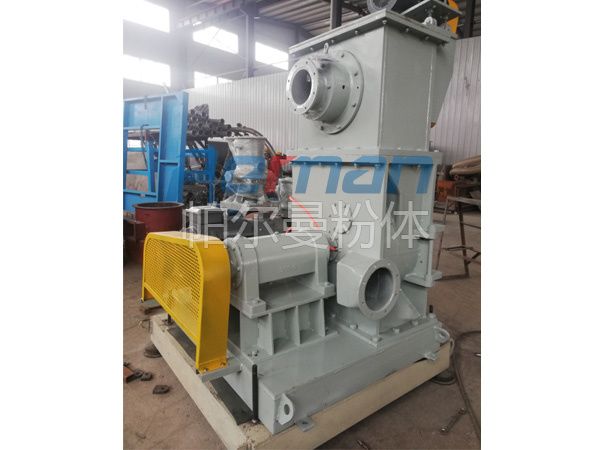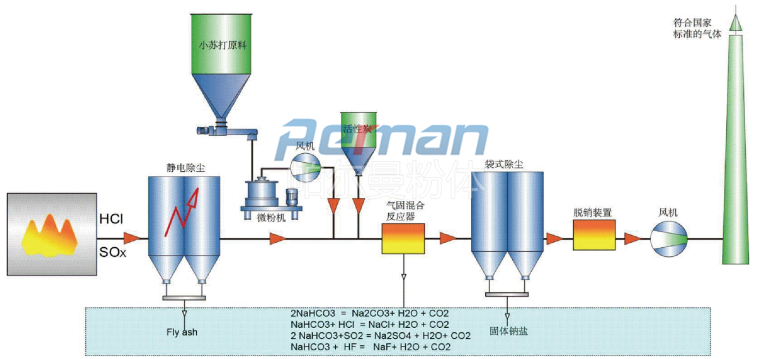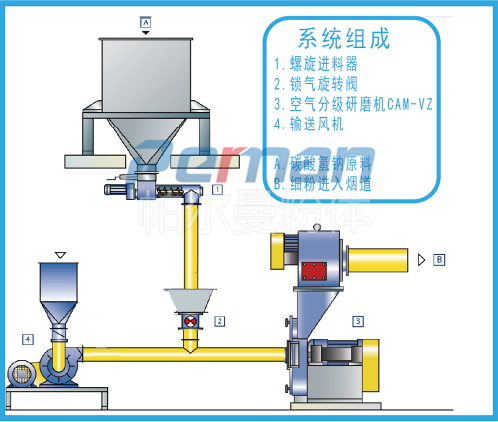CAM-VZ baking soda grinder

With the increasingly stringent requirements of environmental protection regulations, the process based on the baking soda dry deacidification principle developed by Perlman in conjunction with advanced European and American processes has been increasingly used. Various pollutants contained in flue gas are removed by dry adsorption using sodium bicarbonate as adsorbent. Its purification effect is comparable to other known methods, such as the spray adsorption method using lime milk as the adsorbent. Dry flue gas purification can not only be used in coal power plants, hazardous waste treatment, municipal waste or alternative fuel incineration plants, but can also be widely used in industrial furnaces in glass, cement, metallurgy and other industries. Dry flue gas purification can economically remove gases containing acidic substances, such as SO2, HCI, etc., and meet the national flue gas emission standards.
Flue gas contains a large amount of acidic gases. After a large amount of data and experiments, it has been found that only when sodium bicarbonate (baking soda, NaHCO3) is small enough to a certain extent, can it react with the acidic components in the flue gas efficiently. It removes acidic pollutants in flue gas through chemical adsorption, and can also remove some inorganic and organic trace substances through physical adsorption. This process sprays sodium bicarbonate fine powder directly into high-temperature flue gas. At high temperatures, sodium bicarbonate decomposes to produce sodium carbonate Na2CO3, H2O and CO2.
Typically, with flue gas temperatures between 140 and 250 °C, a slight excess of sodium bicarbonate (stoichiometric factor between 1.1 and 1.3) is usually sufficient due to the high activity of the sodium bicarbonate adsorbent.。

The particle requirements are related to the components in the flue gas. For the removal of SO2 and HCl, the required particle sizes will be different. Due to transportation and storage reasons, sodium bicarbonate raw materials are usually coarse particles (d50 value is about 200 microns). To achieve higher reactivity, the adsorbent must have a larger specific surface area. Therefore, sodium bicarbonate must be ground to a certain fineness before being injected into the flue gas pipeline. For example, to remove SO2, the fineness of sodium bicarbonate must reach d90 < 20 µm. The removal of HCl only requires d90 < 35 µm. If the system is operated correctly, more than 95% of SO2 can be removed; the HCl removal rate can even reach 99%. In order to maintain the required fineness of sodium bicarbonate in long-term operation, after grinding with an air grinder, the adsorbent is usually transported by gas transportation and directly introduced into the flue gas pipeline through multiple nozzles to ensure that it is evenly dispersed within the pipeline. . This equipment has a simple and durable design, and its investment and operating costs are lower than other flue gas purification methods. The sodium bicarbonate grinding process will be the core process of this technology.
CAM-VZ positive pressure air grinder
The problem of equipment fouling in negative pressure air grinding systems is often the focus of discussion. Cleaning of equipment, especially conveyor fans, is too time-consuming. In addition, the scale on the fan impeller may peel off during the startup and shutdown processes, causing vibration of the fan and oscillation of its operating status. Therefore, you can consider changing the negative pressure process to a positive pressure process. In the new working mode, the fan is installed before the classifying mill to force process air into the grinding system. The advantage of this working mode is that the ground sodium bicarbonate is not transported through the fan, completely avoiding the problem of fan fouling. In addition, the power consumption of the fan has also been reduced, making the operating cost lower, but it has put forward a higher test for the sealing performance of the equipment. There are strict requirements for the design structure, processing accuracy and coordination of the equipment, and the cost of the equipment has also been will be higher.

Dry adsorption process has made breakthrough progress in removing gaseous inorganic pollutants. This process has become one of the standard processes for removing hydrogen chloride, hydrogen fluoride and sulfur oxides, and is especially suitable for online purification of flue gas from incineration plants. Through the latest developments in process and equipment technology, the performance of dry flue gas purification processes is completely comparable to that of high-efficiency wet processes. The suitability and economics of dry flue gas cleaning processes using sodium bicarbonate require individual analysis in each case. The use of the Perlman CAM series sodium bicarbonate grinding system will make an important contribution to this achievement. The grinding system is flexible and customizable, and the simple and durable equipment effectively improves the availability of the process and the reliability of the flue gas purification process.

